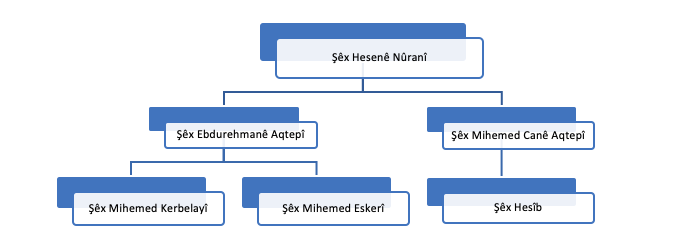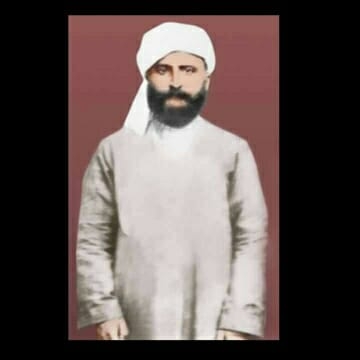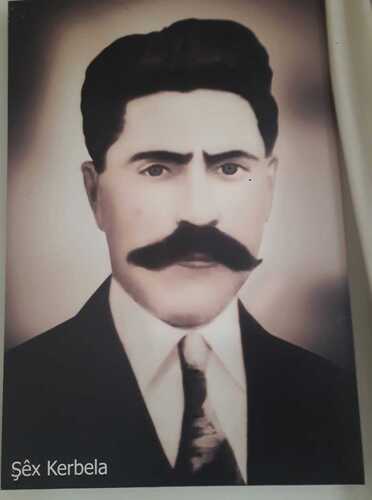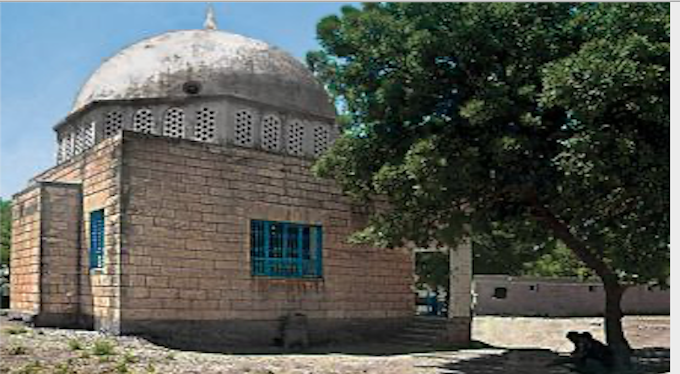This school was founded by Sheikh Hassan Nurani. Sheikh Hassan Nurani's family is from Jolemerg. The family came to Hawel (Baiqan) from Jolemerg. Sheikh Hassan Nurani was born in Hawel. He started his primary education there. Later he went to Botan region and started studying at Basrat school. Sheikh Hassan Nurani studied under the guidance of Mullah Khalil Serti and Sheikh Salih Sipki and became the successor of Sheikh Salih Sipki. Sheikh Salih Sipki asked Sultan Abdulmajid Osmani, who gave him 52 pieces of land in Diyarbakir's Aqtapa Chinara. Sheikh Hassan established a school in Aqtapa that greatly influenced Sufism, Kurdish literature, and language.
A peculiarity of this school is that the representatives of the school are all from the same family. The following table shows the hierarchy of this family:

As the chart shows, six members of this family spent their lives in Sufism and mysticism. We mentioned Sheikh Hassan Nurani above. Now, I briefly mention Sheikh Mohammed Jan. Sheikh Mohammed Jan was born in 1858 in Aqtapa village. He first began his studies in the city, then went to Damascus, where he continued his studies at the Kurdish school of Mawlana Sheikh Khalid Kurdi. After graduation, he returned to Aqtapa and became a teacher at Aqtapa School. He died on March 21, 1909.
Sheikh Mohammed Jan's son, Sheikh Hesp, followed his father and uncle and became a representative of the Aqtapa school.
Why are this family and school called Aqtapa School? For a movement or school to be established or defined by these names, they must have certain characteristics in common. Many common points of this family can be defined as a school. We will now discuss some common points of the representative of this school headed by Sheikh Abdulrahman Aqtapayi.
1-National
As is well known, Sheikh Abdulrahman Aqtapayi and other representatives of this school were influenced by Ahmad Khani, which has led to the nationalist mentality found in the representatives of this school, and if you look at their works, you will find and see this very clearly.
2- Naqshbandi Tariqat
The Naqshbandi sect spread in Kurdistan through Mawlana Khalid Sharazuri and a series of successors. Sheikh Hassan Nurani studied at the Naqshbandi School and succeeded Sheikh Salih Sipki. Thus, this series is passed on to other representatives of the family. Sheikh Abdulrahman Aqtapayi in his work, Rawdun Naima, says:
About the beliefs of Imam Ash'ari of the Naqshi Khalidi sect
The Naqshi Sajjadi belts are among the followers of these saints
3- Alawiyat
Although the society in which the representatives of this school lived is not Alawite, elements and motifs of Alawiteness can be found in the lives of the representatives of this school. We can interpret this because the representatives of this school were influenced by Ahmad Khani, who in his book, "Nawbahara Bachukan", focused on the twelve Imams along with the four caliphs. The second point is the representatives of the Sufi family.
School representatives:
Sheikh Abdulrahman Aqtapi (1850/53 – 1907)
Sheikh Abdulrahman was born in 1850, according to some sources, in 1853 in Aqtapa village. We show from the history of Sheikh Abdulrahman's birth date that after his birth his father Sheikh Hassan came to Aqtapa and built a school there about the same year.
Sheikh Abdul Rahman received his first lessons from his father. After his father's death, Mullah Salim and Mullah Mohammed Amin continued to raise him. However, like many school scholars, Sheikh Abdul Rahman does not continue his studies in his family school and goes to different schools (a characteristic of Kurdistan schools). Sheikh Abdul Rahman and Sheikh Mohaiddin Heni are said to have been educated together in the Qasimiyah Madrasah (school). According to other sources, Sheikh Abdul Rahman studied in Basra and parts of southern Kurdistan, Iraq, and Syria. In conclusion, Sheikh Abdul Rahman was educated in many different places, and this is evident from his knowledge that he received a perfect education.

Sheikh Abdul Rahman came to Aqtapa after graduation. There he married and became a sheikh and teacher of the Aqtapa Madrasah. He continued like this for a while but wanted to replace his brother Sheikh Mohammed Jan in science and writing. That is, Sheikh Mohammed Jan succeeds Sheikh Abdul Rahman. After this, Sheikh Abdul Rahman devoted himself entirely to reading and writing.
Sheikh Abdul Rahman had six children, three sons and three daughters. Two of his sons followed him and stayed in Aqtapa School. Sheikh Mohammad Karbalayi is one of the representatives of the Aqtapa school. Like his father, Karbalayi spent his life on the path of science and knowledge. Karbalayi was exiled during the revolt of Shaikh Saeed, and remained for two years in Ushak and Adan; after the amnesty, he returned to the country and remained in a hujra in Chuli village for the rest of his life. Sheikh Shafi says about his life after the exile: In a long dark room filled with books, on either side and a wooden table on the floor, he read and wrote day and night and then burned what he wrote. Karbalayi died in Chuli village and his grave is next to the grave of his brother, Sheikh Mohammed Askari. Sheikh Mohammed Askari was raised by his father and brother Sheikh Mohammed Karbalayi. He served as a sheikh in Arkhan and Agil of Diyarbakir. It has two important works. One is "Aqdi Durfam" and the other is "Kashkol". Sheikh Askari also died in Chuli village and his grave is in the same village. Sheikh Abdul Rahman Aqtapi chose to be called "Ruhi" but Shamsaddin and Abdul Rahman were also used to address him.
Works:
We will highlight books written in Kurdish and list others too.
Kitabus- Sarf and Nahw (Grammar)
Kitbaul Mantiq (The Book of Logic)
Astronomy
Taqweem (calendar)
The Book of Medicine
Kitab al-Abriz
کشف الظلام فی عقاید فرق الاسلام (Revealing the darkness in the beliefs of the sects of Islam)
منهاج الاصول
رسالة الرابطة
رسالة االدب والاداب
Roud al-Naim: He wrote this book in 1884 when he was 31. This is his most famous and well-known work. It is said to be the most famous book among Kurdish scholars after Mem and Zin and Diwani Mala. The book is written about the Prophet Muhammad. It is difficult, consisting of 35 chapters, each with a different topic.
Diwani Ruhi: Written in 1876 in Kurdish (Kurmanji) and consists of 4531 verses, most of which are referred to as Tarjee band and masnawi, and its context is based on Shamayil, Mehrajyah, Marthiyah, etc.
Sheikh Abdul Rahman died in Diyarbakir in 1907. His relatives are said to have carried his coffin from Diyarbakir to Aqtapa and buried him next to his father. Sheikh Abdul Rahman had a great influence on his followers and many remained under his influence.
Sheikh Mohammed Karbalayi
He is the son of Sheikh Abdul Rahman Aqtapa. He was as knowledgeable and intelligent as his father. He was fluent in Arabic and Persian. He spent his childhood in his village; he began school at the age of seven and completed his education with his father. He then taught in Aqtapa for 15 years. After the uprising of Sheikh Saeed, he was arrested and exiled to Usak and Aden for two years. He died in 1939 in Chuli, which is connected to Diyarbakir.
Works:
Diwan – مرصاد االطفال – د ی وان

Sheikh Askari Aqtapi
Askari was born in 1898 in Aqtapa village; is the son of Sheikh Abdul Rahman. He studied under his father and his elder brother Sheikh Karbalayi. After the death of his father, he lived in Arkhania and Agil. He died in 1952 and was buried in Chuli village.
Works:
Aqdi Durfam, Keshkol









